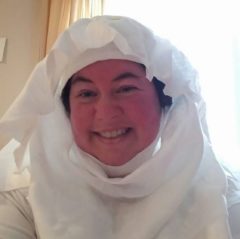I have created these blog posts as an addendum to the YouTube videos: Weave Along With Elewys. While some people learn very well from videos, others learn well from written directions and still images. This blog post will serve that need. I also need to have copies of the patterns that I use in the series available for weavers, and a central location to put them, so this blog will serve that need as well.
We haven’t been able to fully launch the project yet due to mundane demands (we expect it to be ready very soon). Despite the coronavirus Stay at Home orders, mundane work still gets in the way of filming and editing, especially the Intro to Tablet Weaving episode, which is going to be longer than the others as it covers all the materials and tools as well as techniques. I am struggling to do video taping while there are kids, a working husband, and birds in the house, so if you hear thumping, yelping, laughing, chirping, squawking, or another ambient noises, please forgive me. I’m doing the best I can with the resources at hand.
Note: one of the things that I will have to assume in this series is that the weavers are using an inkle loom. If you are using a backstrap, warp-weighted, or box loom, you may need to consult with other resources for directions on how to warp and anchor those.
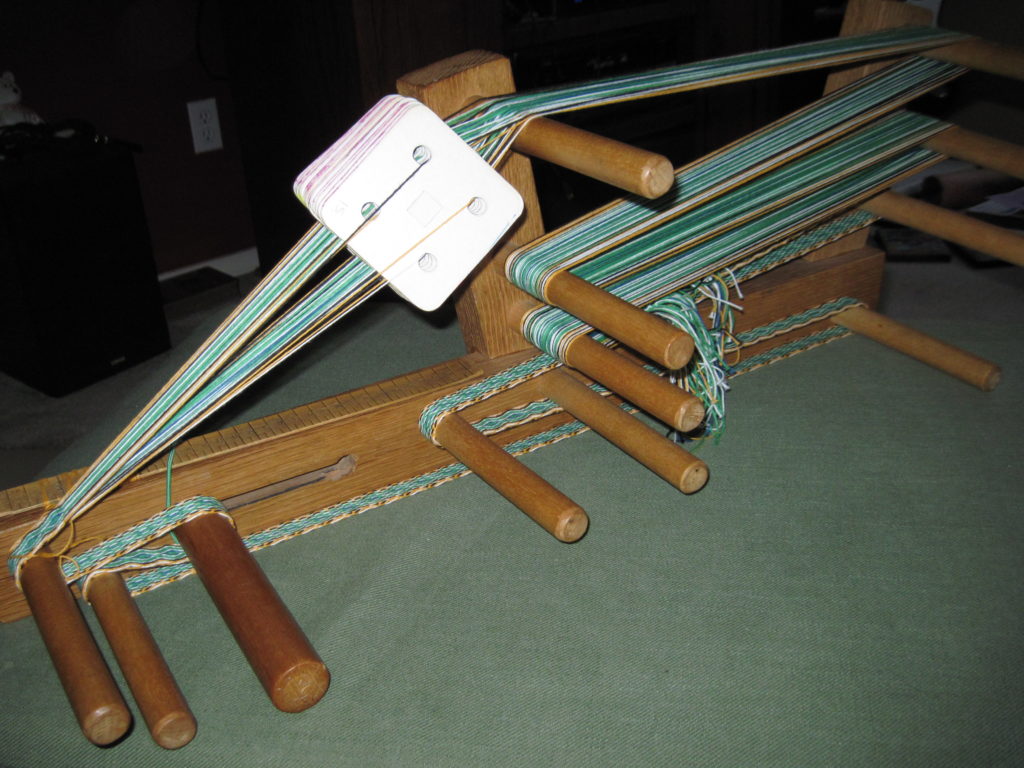
The first episode is a pattern from the Oseberg dig, dating solidly in the Norse era, 834 AD. A large burial mound was discovered at the Oseberg farm near Tønsberg in Vestfold county, Norway. The ship and some of its contents are displayed at the Viking Ship Museum at Bygdøy, Oslo. Among its finds were a loom (commonly called the Oseberg loom), weaving tablets, and a work in progress (known as 34D), as well as this silk piece. The original measured only 5 mm wide–a diminutive little weave–but we’ll do ours in a larger cotton rug warp for this demonstration.
As we have just celebrated the SCA’s 55th birthday, I decided to couple this project with a celebration of the Kingdoms of the Known World in the SCA. I’ve decided to weave 20 pieces in this series in the colors of each of the Kingdoms. The first Kingdom formed was the Kingdom of the West, in 1966. It comprises Northern California, Nevada, Alaska, Japan, Korea and the Pacific Rim. This is where it all started–with a backyard party that turned into an international medieval history organization with tens of thousands of members in 20 kingdoms. All of the Kingdoms, origin dates and colors are, in order:
- The West Kingdom was created when the Society originated in 1966. Colors: green and yellow.
- The Kingdom of the East was created in 1968. Colors: yellow and purple.
- The Middle Kingdom was created in 1969. Colors: red, white and green.
- The Kingdom of Atenveldt was created in 1971. Colors: white, yellow and blue.
- The Kingdom of Meridies was created in 1978. Colors: black and white.
- The Kingdom of Caid was created in 1978. Colors: blue and white.
- The Kingdom of Ansteorra was created in 1979. Colors: yellow, black and red.
- The Kingdom of Atlantia was created in 1981. Colors: green, white and blue.
- The Kingdom of An Tir was created in 1982. Colors: yellow, white and black.
- The Kingdom of Calontir was created in 1984. Colors: purple and yellow.
- The Kingdom of Trimaris was created in 1985. Colors: blue and white.
- The Kingdom of the Outlands was created in 1986. Colors: green and yellow.
- The Kingdom of Drachenwald was created in 1993. Colors: red, yellow and black.
- The Kingdom of Artemisia was created in 1997. Colors: black and yellow.
- The Kingdom of Æthelmearc was created in 1997. Colors: white, red and black.
- The Kingdom of Ealdormere was created in 1998. Colors: white, red and green.
- The Kingdom of Lochac was created in 2002. Colors: red, white and blue.
- The Kingdom of Northshield was created in 2004. Colors: White, yellow and black.
- The Kingdom of Gleann Abhann was created in 2005. Colors: red, white and black.
- The Kingdom of Avacal was created in 2015. Colors: red, white and yellow.
So let’s get started by celebrating the Kingdom of the West!

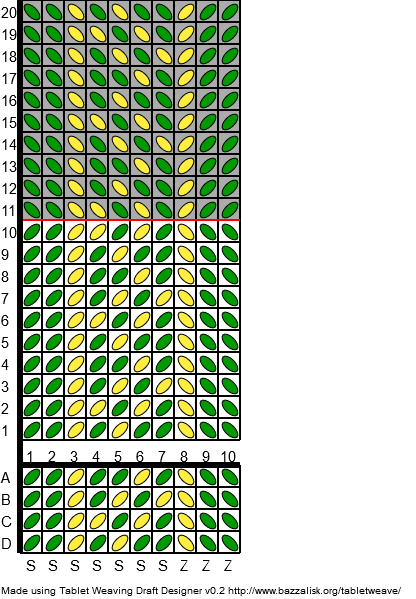
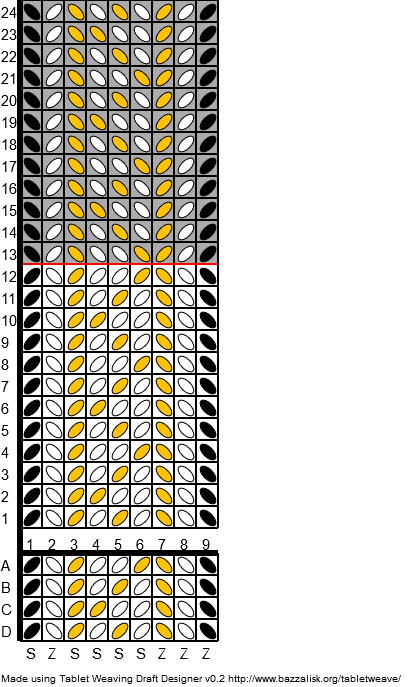
Reading the pattern: squares with a white background are turned forward–away from the weaver. Squares with a grey background are turned backward–towards the weaver. I marked this pattern with the reverse after 10 and 12 turns so you can see what the reverses look like, but you don’t have to reverse so soon. In this particular pattern, the cards all turn the same direction until the warp is over-twisted, then all reversed until they not only become untwisted, but over-twisted in the opposite direction….then it’s back to forward turning again. Repeat this until you reach the end of your warp.
Technique refresher:
Warp your cards with the top of the card facing to the right–this is important if your cards are labeled clockwise. If they are labeled counterclockwise (anti-clockwise), face the tops of the cards to the left.

Get out your Lazy Kate (or whatever facsimile you create…mine is simply a Amazon Prime box with a couple of dowels stabbed through it) and load up your threads.

Thread your cards, making sure to keep your S and Z diagram handy to make sure you are going through the cards correctly.
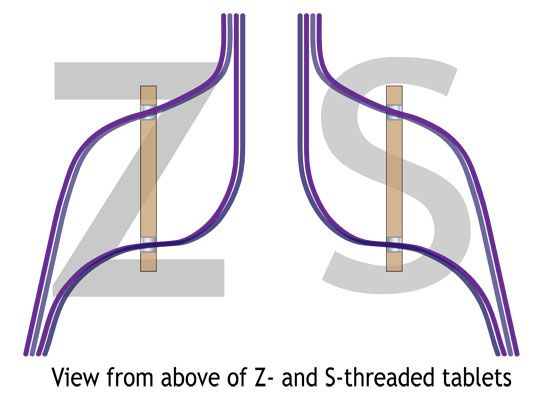
It’s easiest to tie the four threads together for each card, using a surgeon’s knot. It’s similar to a square knot, but has a double throw for the first pass, rather than a single. This makes it easier to untie to adjust tension or to correct mistakes–and trust me, you will make mistakes…we all do.

Once all your cards are threaded, double check your work to make sure they are correctly S and Z threaded and that the colors are in the correct hole. Once you have given it the final inspection, ready your shuttle! I wrap a bunch of warp around the top of the shuttle, in a figure 8 pattern, to keep the thickness of the shuttle to a minimum.

I begin by setting all the cards with AD at the top and slip the tail through the shed so the shuttle is on the left and a 4″ tail is on the right. Turn the cards forward (away from you) and throw the shuttle and the tail in opposite directions, criss-crossing through the shed. This will help anchor the tail and prevent unraveling later. Turn the cards again, beating the weave, and throwing the shuttle, leaving a loop behind. On the next pass, turn the cards, snug up the weft, beat and pull the shuttle through. Don’t be over-zealous on the weft; gently pull the weft thread to pull the warp threads together. Do four turns total so that AD is back at the top again. The first few passes are going to look a hot mess…don’t panic. It’ll get better as you go, and your tension gets more consistent with practice.
Keep weaving along until the twist gets too tight, or every so often (maybe every 10 or 20 repeats, or whenever it moves you), then reverse direction to untwist. You will develop a funny little bump on the edge of the weave–don’t panic…it’s completely normal. The finer the threads you use, the less noticeable it is.
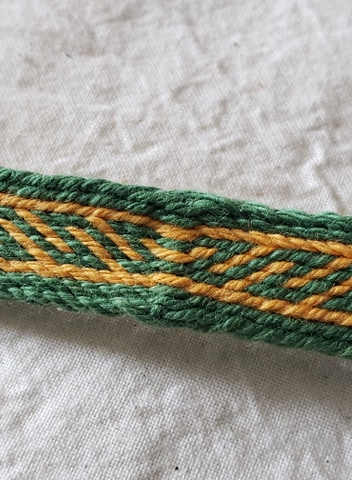
Every so often, you will need to release the tension on the loom, and shift it to continue your work. As you work, you will notice that the length of the weave is getting shorter and shorter…you will lose up to 20% of the warp length from start to finish.
When you get to the end of the warp, you will have 6″ or 8″ left between the end of the weave and the knots tied…remember you will also have the width of the cards and the shuttle between the beginning and end…so if you want to get a minimum length of weaving for a project, you will need to factor that into your warp length.
Some weavers carefully untie all their knots and tie up the ends in a variety of ways. I used to twist and knot the threads, but lately, I’ve decided that it’s far more effort than it’s worth, so I just leave a half inch of fringe and chop off the excess. If you plan on sewing it down as part of trim on a garment, it will likely have the ends tucked inside the seams. It hasn’t unraveled yet, at least using the carpet warp or wool, but finer threads like silk might be more trouble.
I hope this has been a helpful tutorial, and I hope you find the videos helpful as well. I look forward to hearing about my fellow weavers’ projects and anything that I have presented that you, and I’d love to see your completed projects!
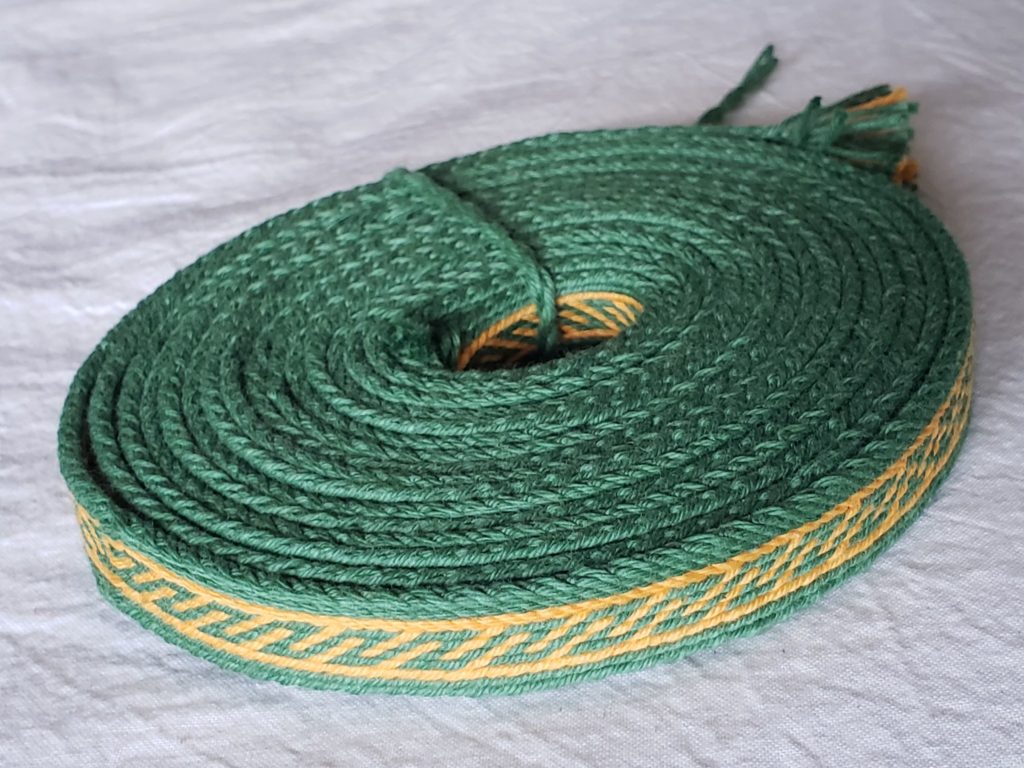
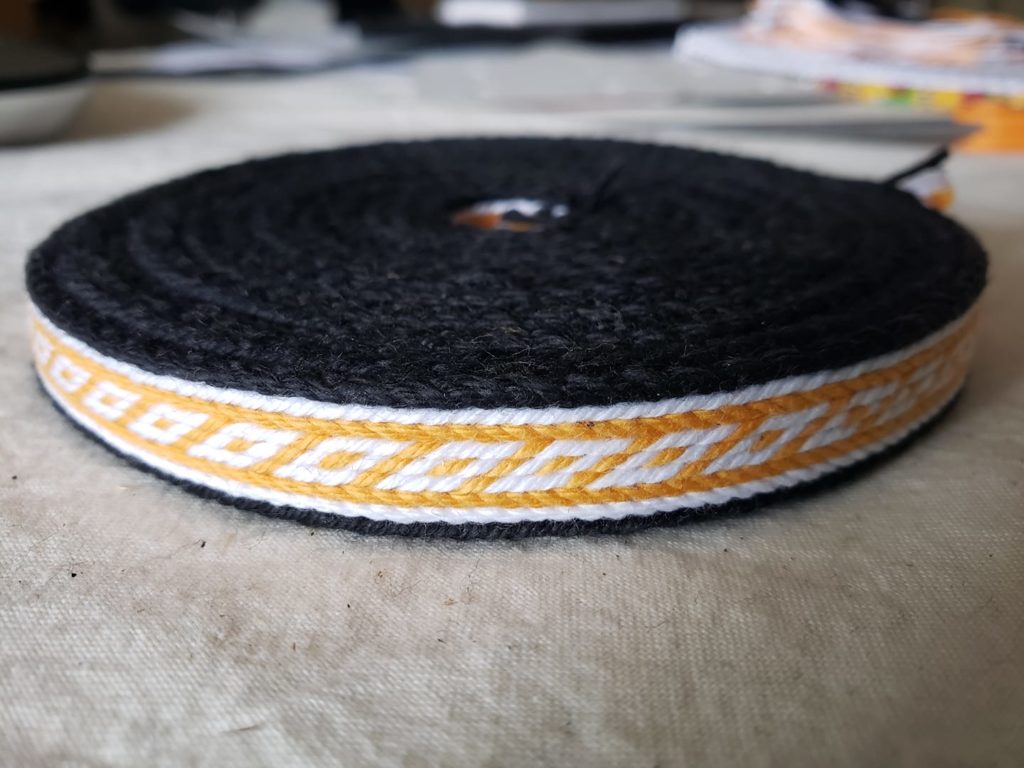
I also wanted to give a shout out and direct you all to a tablet weaving generator that I use a lot, created by a British woman named Catherine. It is both super useful and periodically updated (other generators like GTT haven’t been updated in more than a decade). It can be found at: https://jamesba.github.io/tabletweave/.
